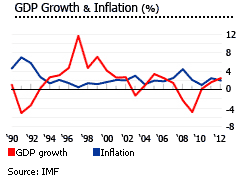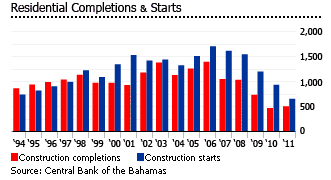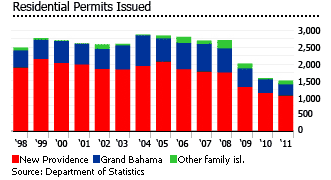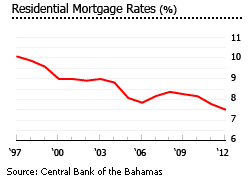Slump in Bahamas property continues
The shadow of the global recession hasn’t left the Bahamas. Though there are no official house price figures, house prices are estimated by local agents to have dropped by 30% to 40% from 2007 to 2010, and according to Treasure Cay Real Estate agent Everett Pinder, they haven’t recovered yet.
Yet improved tourism and a better economic outlook, as well as stabilizing prices, suggest that a market recovery will not long be delayed. Sales volumes are picking up, according to Savills’ Caribbean desk head James Burdess.
The Bahamas Real Estate Association (BREA) recently introduced a new Bahamas Multiple Listing System (BMLS), which suggests a mixed picture:
- Home and condo sales totals in Grand Bahama and the Family Islands were up by 59% q-o-q, from US$ 7 million to just below US$ 12 million. As the number of units sold was down 40% from 15 to 9 units, clearly, there was demand for higher- priced houses.
- In Q3 2012 the total value of home and condo sales in New Providence fell by 45% q-o-q, from around US$ 24 million to less than US$ 15 million, according to the BMLS. Units sold fell from 24 to 20 units.
In Treasure Cay on Abaco Island, according to Pinder:
- inland houses sell for a starting price of US$575,000
- beachfront houses cost around US$3 million and up.
Lots near the beach can be bought from US$1.3 million to US$1.5 million.
In Nassau, New Providence, property prices are 25% to 30% higher than prices in Treasure Cay.

Condominiums in Freeport, Grand Bahama, cost from US$ 80,000 (one bedroom condo) to almost US$2 million (4000 sq. ft. penthouse). Prices of single family homes on the beach in Grand Bahama range from US$500,000 to US$4 million, according to James Sarles of James Sarles Realty.
The Bahamas enjoyed GDP growth of 3% p.a. from 1997 to 2007. Growth halted in 2008 (-2.3% GDP) and 2009 (-4.9% GDP), due to the global financial crisis. Growth was since recovered, with 0.9% growth in 2010, 0.9% and 2011, 2.5% (estimated) in 2012, and expansion of 2.7% expected in 2013.
Tourism is strong
Tourism accounts for around 60% of Bahamas’ GDP, and 50% of employment. Bahamas’ second-largest industry is financial services, which accounts for 20% of GDP.
Visitor figures:
2010: 5.2 million visitors
2011: 5.6 million visitors
2012: 5.7 million visitors (est)

The steady gains in tourism were made possible by new incentives such as the “Companion Fly Free” programme, and airfare credit advertising campaigns.
Private housing construction is weak
Increased tourist arrivals and increased foreign investments paved the way for a construction boom in the private sector after 2006, but in 2009 the global recession caused a significant construction drop. Domestic private sector construction was still weak in Q3 2012, but foreign and public sector investment in construction have picked up, and been major contributors to Bahamas’ economic recovery.

Some of the government’s major infrastructure projects in 2012 (Prime Minister Ingraham’s 2012 State of the Nation Address) include:
- The completion of the US$144 million Phase II expansion of Lynden Pindling International Airport
- Ongoing construction of the US$60 million Airport Gateway Roadway Project in New Providence and is set to be completed in mid-2013
- Opening of two multi-million dollar government administrative office complexes, one in Grand Bahama and the other in Abaco
- Water works in Andros, Exuma, Long Island, Mastic Point, Nicholls Town, Willams Town, and after that in Cat Island, Mayaguana and South Andros
- Completion of US$ 9 million upgrade of Rand Memorial Hospital in Grand Bahama
- Construction of a port in North Abaco

Aside from government projects, the 1,000-acre worth US$3.5 billion Baha Mar mega-resort project on Cable Beach, New Providence, dominates construction sector activity. It includes 2,200 rooms in five high-profile hotels, an 18-hole Jack Nicklaus Signature Golf Course, a convention center, an eco-water park, and a 3,000-feet beach front.
Declining mortgage interest rates

The residential mortgage interest rate in Bahamas was 7.36% in November 2012, the benchmark loan rate having been lowered 75 basis points to 4.50% in May 2011. Mortgage rates floated at around 8% from 2007 to 2010.
The Bahamian residential mortgage has expanded dramatically over the past decade, growing from 20.7% of GDP in 2003, to 41.4% of GDP in 2011. Local banks lend largely to Bahamian households, in local currency (BSD1 = USD1). Real estate purchases by wealthy foreign buyers are mostly paid in cash.
In July 2010, a 2% increase in stamp duty took effect, dampening sales. Two years later, the stamp duty for properties worth over $100,000 was reduced by 2% by the Stamp (Amendment) Bill of May 2012, in an attempt to revive the real estate sector.
Stamp duties are now as follows (this excludes first time home buyers who are exempted from paying stamp duty on homes lower the $500,000):
Properties between $0 and $20,000: - 4%
Properties between $20,000 and $50,000: - 6%
Properties between $50,000 and $100,000: - 8%
Properties $100,001 upwards: - 10%
Rental market yields are good
Property rental yields in Bahamas are moderate to good, based on Global Property Guide research (based only on long-term rentals).
Nassau tends to have the highest average gross rental yields, with inland condominiums yielding around 8%, while waterfront condominiums yield an average of around 7%. Smaller waterfront condominiums have higher yields. Condos of around 120 sq. m. yield 8.16% p.a., while 300 sq. m. condominiums yield less, at 5.70% p.a. Yields in Abaco and Grand Bahama waterfront are moderate, ranging from 3.57% to 4.45%.
Monthly rents for waterfront condominiums in Nassau range from US$2,000 to US$ 5,000 per month. In Abaco and Grand Bahama, rents for waterfront condominiums were at US$ 1,100 to US$ 1,500 per month.
The Rent Control Act applies only to dwellings with a total value of US$75,000 or below, stipulating that rents shall not exceed 15% (p.a.) of the assessed value of the property, and 20% for furnished residences. The luxury vacation rental industry is not covered by this act.
Property ownership by foreigners
There are no restrictions on foreigners buying property, except that a permit from the Government is required before the transaction, if the property is on undeveloped land with an area greater than five acres (20,234 sq. m.).
Foreigners who own properties in the Bahamas are eligible for a homeowner’s residence card (renewable annually) and those who purchase properties valued at least US$500,000 are given priority in permanent residence applications. However, neither permanent nor annual residence gives a foreigner the right to work in the country.
There are many tax advantages and incentives for foreign real estate buyers in the Bahamas. There are no income, sales, and estates taxes. The only direct tax is real property tax.
Taxes
The Bahamas’ tax situation is very attractive to foreigners, many of whom choose to become residents. There are no taxes on income, sales, estates or inheritances. There is no capital gains tax on real estate.
The only direct tax is a real property tax. Real estate taxes are around 1% annually, according to Global Property Guide.